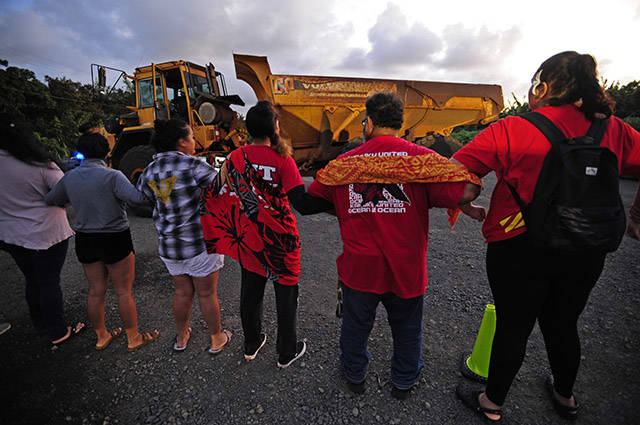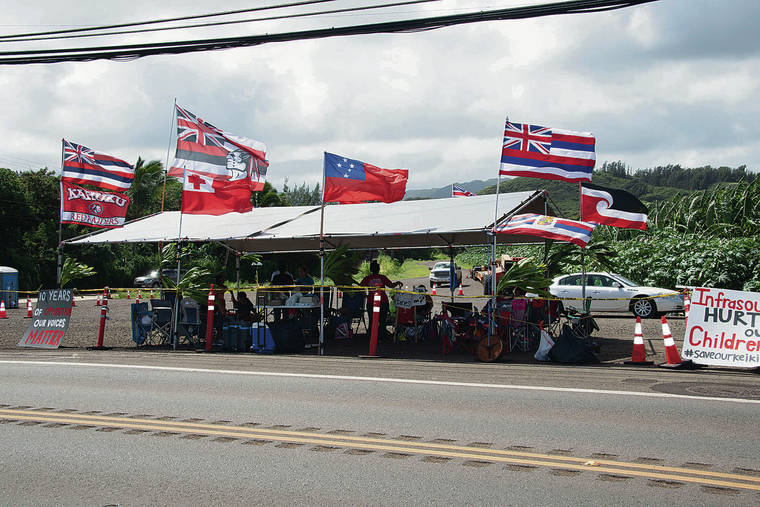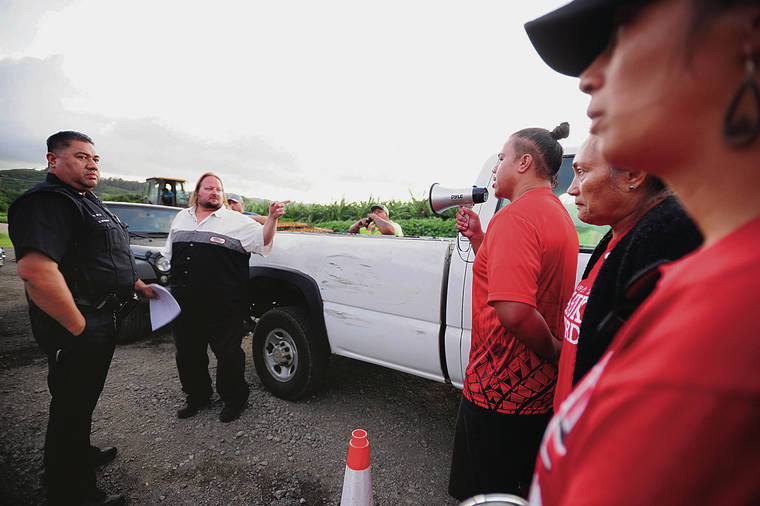Protesters gathered Monday night on a road in Kahuku to block an Oahu wind farm developer from delivering heavy equipment to begin construction in a scene reminiscent of the months-long telescope protests on the Big Island.
For a second straight night, opponents of the Na Pua Makani project rallied to stop a mainland company from proceeding with the legally permitted wind farm.
At around 7 p.m. workers drove vehicles in the direction of the protesters who refused to move. The workers said they had documents giving them the right to proceed. The protesters held their ground. Honolulu police officers arrived and spoke with both sides. The workers eventually pulled back their trucks, and the confrontation ended.
>> Photo Gallery: Residents protest Kahuku wind farm Opens in a new tab
“Mahalo to the police officers,” said Melissa Kaonohi, a protester from Kahuku. “We all stayed in kapu aloha (nonviolent protest). You can easily get angry and upset, but when you remember what you are doing this for and you stay in kapu aloha, we can continue to advocate for our keiki, our community, the aina.”
“We want our children to see that,” Kaonohi said. “We are not protesting. We are protecting.”
The project’s developer, Virginia-based developer AES Corp., said in a written statement Monday afternoon that it held back from its planned delivery of equipment Sunday after considering “a multitude of factors.”
“We are coordinating a complex move that relies on collaboration with government agencies, such as the Honolulu Police Department and Department of Transportation, to keep the roads and community-at-large safe as we make our way up to the North Shore,” Mark Miller, the company’s chief operating officer of U.S. power generation, said in the statement.
Miller also said AES respects people’s passion for voicing their opinions, and noted that the company has committed to $4.5 million in community benefit contributions.
“Dialogue is important, and we have done a tremendous amount of work to understand how the project impacts this community and what we can do to become a good community partner,” he said.
AES intended for Sunday to be the start of a seven- week schedule for delivering turbine parts from Kalaeloa Harbor, where pieces weighing over 100,000 pounds were shipped, to the Kahuku project site leased from the state.
Protesters stood along a road in Kalaeloa on Sunday night and rallied in Kahuku before the company decided to hold off on moving equipment as planned.
The protesters said they were committed to keeping the machinery from being delivered.
“We do plan to stand our ground because our kids and our kupuna and our community, they’re important to us and we plan to stay out there for as long as we have to to ensure the safety of our people and our community and Native Hawaiian wildlife,” said Kananiloaanuenue Ponciano, president of Ku Kiai Kahuku, the group opposing the wind farm.
Ponciano said, “There has been an overwhelmingly wave of love and support not only from our community, but the entire island of Oahu.”
Ayesha Liquorish of Ku Kiai Kahuku said Kahuku, which has about 2,300 residents, will be surrounded by wind turbines if AES adds eight more turbines as planned. “What other community is surrounded by turbines?” she asked.
The Sunday and Monday protests and work disruption represent the latest tactic to derail the project, which has been in the works for over a decade.
Na Pua Makani was initially proposed by Oregon- based West Wind Works in 2006 and was later transferred to a second company and then AES, operating in Hawaii as Na Pua Makani Power Partners.
The project involves eight turbines generating up to 25 megawatts of electricity daily, or enough to power about 16,000 homes and at half the cost of burning oil.
AES reduced the number of turbines from an initial 13 but increased the size of the turbines. Some Kahuku residents supported the plan, but others have raised concerns about what would be a third wind farm on the North Shore.
One of the main complaints is that AES has positioned its turbines too close to homes, farms and Kahuku Elementary School.
Jessica dos Santos, a Ku Kiai Kahuku leader, previously said AES representatives disclosed at a community meeting last month that the closest turbines would be 1,648 feet from a residential area and 1,750 feet from the school. She also said that farms where people reside would be only 750 feet from a turbine.
AES has denied that there would be any harmful effects on area residents from the proximity of its turbines, and said it is complying with setback requirements under city rules.
Another objection has to do with turbines killing Hawaiian hoary bats. AES has agreed to mitigation measures to improve bat habitat that offsets expected incidental deaths, but some project opponents have said the bats are sacred animals in Hawaiian culture that they need to protect.
AES has a state permit for expected bat fatalities. The project also completed an environmental review, and in 2016 obtained a 40-year state land lease from the state Department of Land and Natural Resources.
The lease approval was challenged in a contested- case hearing over the bat issue that was decided in the developer’s favor, then appealed to state court and upheld earlier this year by a state Circuit Court judge. An appeal to the court ruling is pending.
Last month, local environmental organization Life of the Land sought to invalidate a 2013 power purchase agreement between the wind farm developer and Hawaiian Electric Co. in a filing with the state Public Utilities Commission.
On Thursday, community group Keep the North Shore Country asked two state agencies to suspend a permit for AES to transport turbine parts over six historic North Shore bridges.
The group said in a letter to the state Department of Transportation and DLNR that some of the bridges can’t handle AES payloads upward of 55 tons, or 110,000 pounds.
Lance Collins, an attorney representing the group, said in the letter that DOT reduced the allowable load on Paumalu bridge to 15 tons pending improvement work that has not been completed.
“Simply put, the transport of these overweight trucks over these historic bridges threatens to cause the bridges to fail,” the letter said.
Ed Sniffen, DOT Highways Division deputy director, said in a statement Monday that all bridges and other infrastructure along the AES transport route have sufficient capacity to safely handle the loads anticipated.
AES had expected deliveries starting Sunday night would continue over the next seven weeks Sunday through Friday morning between 11 p.m. and 5 a.m. until Nov. 26.
AES has said it began construction work in Kahuku in January and anticipated completing the project next summer.








